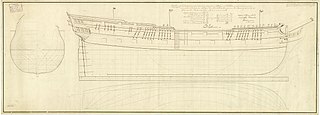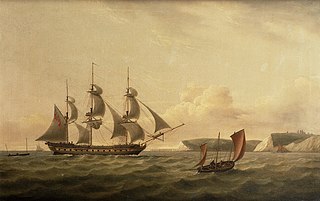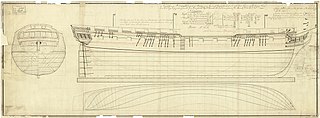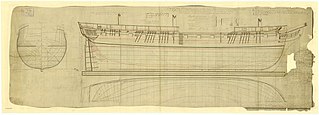
HMS Minotaur was the lead ship of the Minotaur-class armoured frigates built for the Royal Navy during the 1860s. Minotaur took nearly four years between her launching and commissioning because she was used for evaluations of her armament and different sailing rigs.

HMS Amazon, was a 36-gun Amazon-class frigate, built at Rotherhithe in 1795 to a design by Sir William Rule. Carrying a main battery of 18-pounder long guns, she was the first of a class of four frigates. She had a short but eventful career during the French Revolutionary War, which she spent in the Channel and Western Approaches, part of a frigate squadron under Sir Edward Pellew. She was wrecked in Audierne Bay in 1797, following an action on 13 January with the French ship-of-the-line, Droits de l'Homme.

The Roebuck-class ship was a class of twenty 44-gun sailing two-decker warships of the Royal Navy. The class carried two complete decks of guns, a lower battery of 18-pounders and an upper battery of 9-pounders. This battery enabled the vessel to deliver a broadside of 285 pounds. Most were constructed for service during the American Revolutionary War but continued to serve thereafter. By 1793 five were still on the active list. Ten were hospital ships, troopships or storeships. As troopships or storeships they had the guns on their lower deck removed. Many of the vessels in the class survived to take part in the Napoleonic Wars. In all, maritime incidents claimed five ships in the class and war claimed three.

HMS Pallas was one of the three 36-gun Venus-class fifth-rate frigates of the Royal Navy. She was launched in 1757 and initially served in Sir Edward Hawke's fleet blockading the coast of France where she fought at the Raid on Cherbourg and in the Battle of Bishops Court. She later served for a number of years in the Mediterranean Sea before moving to serve off the coast of Africa between 1774 and 1776 where she protected the isolated British colonies. In 1778 she joined the Newfoundland Station and participated in the attack on Saint Pierre and Miquelon. Pallas returned to the English Channel after this and assisted in destroying a French invasion force intended for the Channel Islands in 1779 before briefly serving on the Jamaica Station. In 1783 she was beached on São Jorge Island after she was found to be heavily leaking; she was burned there on 24 February.

HMS Brilliant was a 36-gun Venus-class fifth-rate frigate of the British Royal Navy that saw active service during the Seven Years' War with France. She performed well against the French Navy in the 1760 Battle of Bishops Court and the 1761 Battle of Cape Finisterre, but was less capable when deployed for bombardment duty off enemy ports. She also captured eight French privateers and sank two more during her six years at sea. The Royal Navy decommissioned Brilliant in 1763. The Navy sold her in 1776 and she became an East Indiaman for the British East India Company (EIC). Brilliant was wrecked in August 1782 on the Comoro Islands while transporting troops to India.

HMS Cato was a 50-gun Grampus-class fourth rate ship of the Royal Navy. One of a class of ships constructed for service in the American Revolutionary War, Cato was commissioned in 1782. She became the flagship of Sir Hyde Parker, and sailed with him to the East Indies Station later in the year. After stopping at Rio de Janeiro on 12 December, the ship sailed for the Cape of Good Hope and was never seen again. Theories on her disappearance include her being shipwrecked in locations such as the Malabar Coast and the Maldives, and the crew being murdered by natives. Sir John Knox Laughton argues that it is more likely that Cato caught fire and blew up at sea.

HMS Resistance was a 44-gun fifth-rate Roebuck-class ship of the Royal Navy launched in 1782. Based on the design of HMS Roebuck, the class was built for use off the coast of North America during the American Revolutionary War. Commissioned by Captain James King, Resistance served on the West Indies Station for the rest of the war. She captured the 24-gun corvette La Coquette on 2 March 1783 and then went on in the same day to participate in the unsuccessful Battle of Grand Turk alongside Horatio Nelson. Resistance then went for a refit in Jamaica, during which time King fell ill and was replaced by Captain Edward O'Bryen. O'Bryen commanded Resistance until March 1784 when she was paid off. In 1791 she was recommissioned as a troop ship, but was converted back into a warship in 1793 at the start of the French Revolutionary War, under Captain Edward Pakenham.

HMS Jason was a 36-gun fifth-rate Penelope-class frigate, launched in 1800. She served the entirety of her career in the English Channel, mostly in the frigate squadron of Commodore Charles Cunningham. Serving off the coast of France, especially around Le Havre and Cherbourg, she captured several French privateers and recaptured a British merchant ship in a cutting out expedition. Having only been in commission for around fifteen months, Jason was wrecked off the coast of St Malo on 21 July 1801. Her crew were saved and later exchanged, and in August her wreck was burned to prevent the French from rescuing it.

HMS Hussar was a 38-gun fifth-rate Amazon-class frigate of the Royal Navy. Launched at the end of 1799, the entirety of the frigate's career was spent serving in the English Channel and off the coast of Spain. Hussar primarily served as a convoy escort and cruiser, in which occupation the frigate took several prizes, including the French privateer Le General Bessieres. Towards the end of 1803 Hussar was sent to serve in Sir Edward Pellew's Ferrol squadron. On 8 February 1804 Hussar was returning to England with dispatches when the ship was wrecked off the coast of Île de Sein. The crew attempted to sail for home in a fleet of commandeered boats, but the majority were forced to go into Brest to avoid sinking in bad weather, where they were made prisoners of war.

The Perseverance-class frigate was a 36-gun, later 42-gun, 18-pounder fifth-rate frigate class of twelve ships of the Royal Navy, constructed in two batches. Designed by Surveyor of the Navy Sir Edward Hunt the first iteration, consisting of four ships, was constructed as a rival to the similar Flora-class frigate. Strongly built ships, the Perseverance class provided favourable gunnery characteristics and was highly manoeuvrable, but bought these traits with a loss of speed. The name ship of the class, Perseverance, was ordered in 1779 and participated in the American Revolutionary War, but her three sister ships were constructed too late to take part. The class continued in service after the war, but soon became outdated.

HMS Resistance was a 36-gun fifth-rate Aigle-class frigate of the Royal Navy, one of a pair designed by Sir John Henslow. Resistance was commissioned in May 1801 by Captain Henry Digby, and after brief service in the English Channel the frigate left for Quebec in charge of a convoy. While on voyage Resistance captured the French privateer Elizabeth, which was the last ship captured during the French Revolutionary War. Having returned to England at the end of the year, the frigate resumed service in the English Channel, with Captain Philip Wodehouse replacing Digby. On 31 May 1803 Resistance was sailing to the Mediterranean Sea when she was wrecked off Cape St. Vincent; the crew survived.

The Narcissus-class frigate was a 32-gun, 18-pounder fifth-rate frigate class of five ships of the Royal Navy. Designed by Surveyor of the Navy Sir John Henslow, the class was created to make use of shipyards that could not construct larger frigates. They were similar in design to the preceding 32-gun frigate class, the Amphion class, but were slightly shorter. Two ships were initially constructed, with a later batch of three being ordered in response to an Admiralty request for the resumption of production of proven frigate designs. The final two ships of the class were cancelled when the shipyard they were being constructed at went bankrupt. Unlike her sister ships, the name ship of the class Narcissus was armed with experimental short 24 pounders rather than 18 pounders.

Aigle-class frigates were 36-gun sailing frigates of the fifth rate designed by Surveyor of the Navy, Sir John Henslow for the Royal Navy. Only two were built: HMS Aigle and HMS Resistance. Aigle was ordered first on 15 September 1798 but a 16-month delay during her construction meant that Resistance was completed and launched first on 29 April 1801.

The Wolfe-class ship of the line was a 112-gun first-rate ship of the line class of two ships of the Royal Navy. The class was ordered during the arms race on the Great Lakes during the War of 1812 between Britain and America. Built at Kingston Royal Naval Dockyard, the ships were similar in design to their predecessor on Lake Ontario, the 102-gun HMS St Lawrence, but also included a quarterdeck or poopdeck. The two ships of the class, Wolfe and Canada, were laid down towards the end of 1814 but had not been completed when the war ended in the following year. Construction was suspended and the ship frames were left at the dockyard until 1831 and 1832 respectively when they were cancelled.

HMS Manilla was a 36-gun fifth-rate Apollo-class frigate of the Royal Navy. Commissioned by Captain George Seymour in September 1809, Manilla's first service was in a squadron operating in the Tagus. She conveyed Lieutenant-General Sir John Sherbrooke to Halifax, Nova Scotia, in late 1811, returning to England with Lieutenant-General Gordon Drummond.

HMS Endymion was a 44-gun fifth-rate Roebuck-class ship of the Royal Navy launched in 1779. Based on the design of HMS Roebuck, the class was built for use off the coast of North America during the American Revolutionary War. Commissioned by Captain Philip Carteret, Endymion spent the war serving in the English Channel and West Indies. There, she was damaged in the Great Hurricane of 1780. Sent to England for repairs, Endymion returned to the West Indies in 1782, repeating signals at the Battle of the Saintes. She was present but not engaged at the action of 2 January 1783, before being paid off towards the end of the year.

HMS Experiment was a 44-gun fifth-rate Roebuck-class ship of the Royal Navy launched in 1784. The ship spent her entire career serving as a troop ship, store ship, or lazarette. Initially stationed in the West Indies, Experiment participated in the Battle of Martinique and Invasion of Guadeloupe in 1794. While travelling to Halifax, Nova Scotia, in 1797, the ship captured several high-value Spanish merchant ships, and subsequently returned to Britain. In 1801 she travelled to the Mediterranean Sea where she participated in the Egypt Campaign, with her boats serving as landing craft at the Battle of Abukir.

HMS Assurance was a 44-gun fifth-rate Roebuck-class ship of the Royal Navy launched in 1780. Commissioned in the same year, the ship served throughout the remainder of the American Revolutionary War on the North America Station. Her service there included capturing the American privateer Rattlesnake on 17 June 1781 and coordinating the evacuation of Savannah, Georgia, in July 1782. Having briefly served as a troop ship during the subsequent peace, Assurance was recommissioned in 1793 for the French Revolutionary Wars. Operating in the West Indies, she served in Sir John Jervis' fleet that captured Martinique, St Lucia, and Guadeloupe in March and April 1794, also playing a part in the capture of the French frigate Bienvenue on 17 March.

HMS Actaeon was a 44-gun fifth-rate Roebuck-class ship of the Royal Navy launched in 1778. Commissioned in the same year, the ship served throughout the remainder of the American Revolutionary War. After initially serving in the North Sea and in the defence of the Channel Islands, in 1779 Actaeon joined the Jamaica Station, participating in the capture of Goree on 8 May as she travelled there. She spent time guarding Saint Lucia and Tobago, going to Britain to be repaired before returning to Jamaica in 1781. The ship formed part of a squadron that supported Edward Despard in his capture of the Black River settlement at the Battle of the Black River on 30 August 1782, and then returned to Jamaica to spend the rest of the war patrolling the West Indies.

HMS Regulus was a 44-gun fifth-rate Roebuck-class ship of the Royal Navy launched in 1785. Not commissioned until 1793 for the French Revolutionary Wars, Regulus served predominantly as a troop ship. After initial service in the English Channel she moved to the Jamaica Station where she saw action around Hispaniola and Puerto Rico. Returned to Britain in 1799, the ship served during the Egypt Campaign in 1801 and was present at the Battle of Abukir.
















